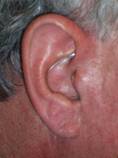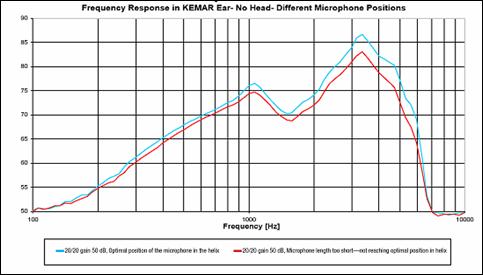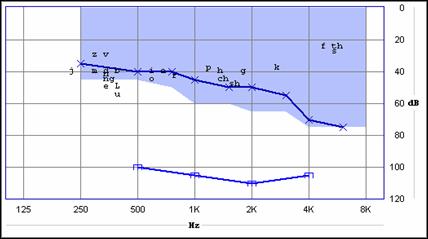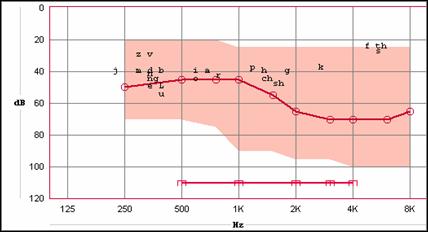Interview with Robin Donham, Au.D., National Product Training Manager, Interton
Topic: Interton's DASH
CAROLYN SMAKA: This is Carolyn Smaka from AudiologyOnline and today I'm speaking with Dr. Robin Donham from Interton. Thanks for speaking with me today, Robin.

Robin Donham, Au.D.
ROBIN DONHAM: Thanks for having me, Carolyn

SMAKA: Robin, can you tell me about your background and your role is at Interton?
DONHAM: Sure thing. I am the National Product Training Manager for Interton. My role is to train our staff, as well as dispensers and audiologists on new products, software, and technologies that are integrated into the Interton family from our sister company, GN Resound. When we introduce new technology, I teach our staff and customers. I also conduct online product training and create training DVDs for Interton. We do more virtual and DVD trainings than most companies because we keep a limited staff. This gives us the ability to reduce our prices because we don't have as much overhead.
I really enjoy what I do. My parents and my sisters are either preachers or teachers, so I come from a teaching family.
SMAKA: Thanks, Robin. Our topic today is a new product from Interton, DASH. Robin, what style of hearing aid is DASH?
DONHAM: One of the interesting things about DASH is that it's a brand-new form factor. It is a custom product that features what consumers are looking for by combining some of the best things that we've learned from receiver-in-the-ear technology, Behind The ear (BTE) technology, and custom products. Historically, manufacturers have offered traditional BTE and custom hearing aid designs for ages. Then, the first Completely-in-Canal (CIC) products came out, which were custom, and of course, everybody wanted that primarily for the cosmetic appeal. Next, we saw the emergence of open ear and receiver-in-the-canal technology, and those form factors have evolved as well. Now, with the launch of DASH, Interton has redefined open-ear technology, custom technology, and BTE technology by combing the best aspects of each into this one new form factor we call "microphone-in-helix technology" or microphone-in-helix (MIH).
SMAKA: Can you explain exactly what a MIH form factor is?
DONHAM: Absolutely. Let's start with the best features of the various traditional hearing aid styles. We know what patients with hearing loss are generally looking for a custom device, that's small, cosmetically appealing, fits into the canal, is easier to insert and remove from the ear, has few components to take care of, and is generally hassle-free. What do patients like about BTEs? They like the models that are open, have less occlusion which makes them more comfortable, and can be fit in one visit, without having to wait for custom earmolds.
Now, let's look at some problematic areas with these styles. In The Ear (ITE) styles may be limited by occlusion, comfort, and wind noise. BTEs have their disadvantages, too - additional components such as tubing, earmolds or eartips to maintain and care for, noise from hair brushing up against the microphone, they are more difficult to insert, and they are perceived as having additional bulk. Many patients wanting hearing aids do not want something that fits over their ears. Even with the newer styles, we're not going to convince many patients to get an over-the-ear or BTE device - it is just not going to happen.
Additionally, we learned from receiver-in-the-ear devices that when the receiver is fit down into the ear, we can run a wire up to the body of the device and put the microphone and the processing components in that BTE casing. With the separation of the receiver and the microphone, we can smooth out the frequency response, making it better than an open tube BTE fitting where the receiver is in the aid. The separation also allows for less internal device noise and more gain to be provided.

Interton DASH 10
The microphone-in-helix form factor combines the best of ITE and BTE styles by removing the bulky BTE casing and fitting those components in a comfortable casing that fits into the patient's ear canal. The separation of microphone and receiver, one of the benefits of receiver-in-the canal devices, is achieved by the remote microphone which runs via a wire up the back of the concha bowl to the anti-helix.
The microphone is placed externally, but still within the pinna and still hidden within the concha bowl—that's a new form factor. That's why we're calling it a remote mic. Most of the components stay inside the ear, like a typical ITE or CIC device, but with the wire we are able to move the microphone. By moving the microphone placement we're keeping the cosmetic appeal of a custom device, enabling easier device insertion for our patients, and taking advantage of natural wind noise protection because the mic is hiding in the anti-helix where it's protected.
SMAKA: How does this compare to typical wind-noise reduction methods in other devices?
DONHAM: With natural wind-noise reduction, DASH provides protection against wind noise without having to lower prescribed gain like some manufacturers are doing at approximately 400 Hz when wind is detected. We don't want to reduce gain;we want to provide natural protection from wind noise. DASH does that perfectly with the placement of the microphone remotely in the anti-helix.

Interton DASH in situ
SMAKA: Does the microphone-in-helix provide any other benefits?
DONHAM: Great question. The remote mic is also placed at the perfect point for sound collection. Because of this placement, we utilize the ear's natural pinna effects. Placing the microphone in this location we're also going to have an optimal placement for directivity index for sound collection and we'll have increased high frequency gain.
Pulling that microphone out of the shell also opens up the canal. We have more room in the shell now, and can implement larger vent sizes, so we are combating occlusion. We can provide more gain, in fact, the superpower DASH has as much gain as a full powered ITE device. And with DASH, it's tiny and not visible like an ITE. You can even get multi-programs with DASH.

The DASH family of products
SMAKA: Does DASH include features like noise reduction and directionality?
DONHAM: DASH is a single microphone device, which deviates from traditional directional hearing aid thinking. Typically, directional devices require two microphones. However, DASH is able to provide patients directionality because of where the remote mic is located. The mic sits in that critical part of the pinna where our ears are naturally designed to collect more sounds in the speech frequency ranges. Patients are given a natural directional benefit just because of mic placement and pinna effects. Additionally, patients will get the benefit of two to three more dB in the high frequencies for the same reasons.

Natural Sound Collection ability of DASH
Noise reduction, for all of our families, from Avio1, Avio3, Avio5 and now DASH, is designed to determine where speech is and where noise is on a three dimensional level. We know already that speech has energy in mostly high or mostly low frequencies. By using the actual energy of the speech behaviors and not just modulation, we can more accurately identify speech in the presence of noise. So the first thing that the adaptive noise reduction is going to do for DASH is identify speech and differentiate between speech and noise. This feature is going to look at modulation, frequency transitions, and the energy of the speech behavior to accomplish this. Once we identify speech, we determine if the speech is in the presence of noise. Then we use spectral subtraction for the noise. A thousand times per second the hearing aids are going to look at breaks in speech, because most conversations are based around turn-taking. During that break in speech, a noise estimate is derived. This noise estimate is pulled out across frequency in all of our channels. The noise estimate is spectrally subtracted from the entire signal. Running parallel with all of this are algorithms for speech probability. These examine when speech is occurring in the environment, and the algorithms are going to put more preference for gain on the speech signal.
SMAKA: Can these features be adjusted to fit individual patient preferences?
DONHAM: You bet. A big difference with Interton, and DASH, is we give you more preferences and more options in the software. How much do you want to reduce that noise estimate? Do you want mild -3 or moderate -6 of the noise estimate to be spectrally subtracted?
In the product development, we have considered what our patients really want. They want natural, normal hearing. Of course, we can't do that with hearing aids, but DASH is a huge step toward giving back natural, normal sound collection and sound quality. And we haven't even touched on Warp™ processing yet.
SMAKA: Tell me more about Warp processing.
DONHAM: Interton refers to Warp processing as logarithmic wide dynamic range compression (WDRC). The goal is to mimic the normal function of the auditory filters in the cochlea. It delivers extreme speed and precision, mimicking the function of the cochlea with near zero distortion as well as a smooth frequency response.
SMAKA: Does DASH replace a previous product, like the Avio series?
DONHAM: No. There are benefits to both families. The Avio5 family is a full product family - - CIC, ITC, ITE and half shell. It also includes receiver-in-the-canal, over-the-ear devices, both mini devices that use a 312 battery or over-the-ear devices with a 13 battery. They all include learning volume control that enables patients to set the aid's overall gain according to specific environments. Because of its tiny size, DASH does not feature manual volume controls. Avio and DASH products are two distinct lines with distinct benefits for different types of patients.

DASH compared to a U.S. dime
SMAKA: Robin, at the start of the interview you mentioned that DASH is custom. Just to be clear - is DASH custom fit or is it an instant fit solution?
DONHAM: DASH is a custom fit device. We decided that it's critical to the placement of the microphone and to the comfort inside the canal to custom build these devices. Even the wire that connects the microphone to the in-ear components is custom built for each patient. This ensures that we seat the microphone in the correct place within the anti-helix and maintain the directivity index that we talked about earlier.
SMAKA: Is there anything different in terms of impression taking techniques that professionals should keep in mind when ordering this new form factor?
DONHAM: Yes, there are some things that we want people to be mindful of when they're making an impression. With impression for a standard CIC, the concha bowl and helix portion of the impression is not as important. With a DASH CIC, however, we need the impression to include the full concha and helix so that we can custom build the wire and microphone for optimal comfort. This full concha and helix impression basically allows us to place the wire and the microphone in exactly in the right place for comfort, sound collection, wind-noise reduction, and directivity. Without a full impression that includes this area of the patient's ear, this is difficult to achieve.
SMAKA: That doesn't sound like anything out of the ordinary - just take an impression that fills the concha bowl, as you would for an ITE.
DONHAM: Exactly.
SMAKA: Robin, can you tell me who are candidates for DASH - both from an audiological profile as well as lifestyle?
DONHAM: Certainly. From an audiological profile, DASH fits about 95 percent of all patients with hearing loss. Fifty-nine percent of the population has a hearing loss due to presbycusis. These losses typically start in the low frequencies at about 30 - 40 dB HL, and then gradually slope to a moderately-severe hearing loss in the high frequency range. That type of loss is appropriate for both the standard DASH CIC and the standard DASH ITC. The DASH ITC also has a super power option with a full-on gain up around 60 dB.
From a lifestyle perspective, DASH meets the needs of active patients looking for a comfortable, cosmetically appealing device with important features such as feedback cancellation, directionality, noise reduction and wind noise reduction.


DASH standard CIC (top) and DASH Power-ITC (bottom) fitting ranges
SMAKA: Is DASH available today if I wanted to place an order for a patient?
DONHAM: Yes.
SMAKA: You mentioned that you're in charge of training. If I want training on DASH, what are my options?
DONHAM: We offer a series of online trainings, and you can check our website for dates and times. The online trainings are also recorded, so you can access DASH training 24/7. In addition, there is a 1-hour CEU in-office appointment that you can get from our outside account manager. I've also just completed a 20-minute DVD with the basic information you would want to know on DASH that will be available for viewing and downloading athref="https://www.simplyinterton.com">www.simplyinterton.com. It includes information about the features, software, fitting DASH, and more.
I am really excited about DASH. Interton has been able to incorporate a lot of great technology from GN Resound into the Avio5 series and now in DASH. We've managed to place all this technology into simple packaging and reduce the price point a lot, while maintaining quality. Our products offer patients economy and an assortment of options they want.
SMAKA: Thanks for all your time, Robin. Wishing you much success with DASH.
DONHAM: Thank you, Carolyn.
About Interton
To learn more about DASH and other Interton products, visit the Interton WebChannel on AudiologyOnline or Interton's website, www.interton.com.

Robin Donham, Au.D.
ROBIN DONHAM: Thanks for having me, Carolyn

SMAKA: Robin, can you tell me about your background and your role is at Interton?
DONHAM: Sure thing. I am the National Product Training Manager for Interton. My role is to train our staff, as well as dispensers and audiologists on new products, software, and technologies that are integrated into the Interton family from our sister company, GN Resound. When we introduce new technology, I teach our staff and customers. I also conduct online product training and create training DVDs for Interton. We do more virtual and DVD trainings than most companies because we keep a limited staff. This gives us the ability to reduce our prices because we don't have as much overhead.
I really enjoy what I do. My parents and my sisters are either preachers or teachers, so I come from a teaching family.
SMAKA: Thanks, Robin. Our topic today is a new product from Interton, DASH. Robin, what style of hearing aid is DASH?
DONHAM: One of the interesting things about DASH is that it's a brand-new form factor. It is a custom product that features what consumers are looking for by combining some of the best things that we've learned from receiver-in-the-ear technology, Behind The ear (BTE) technology, and custom products. Historically, manufacturers have offered traditional BTE and custom hearing aid designs for ages. Then, the first Completely-in-Canal (CIC) products came out, which were custom, and of course, everybody wanted that primarily for the cosmetic appeal. Next, we saw the emergence of open ear and receiver-in-the-canal technology, and those form factors have evolved as well. Now, with the launch of DASH, Interton has redefined open-ear technology, custom technology, and BTE technology by combing the best aspects of each into this one new form factor we call "microphone-in-helix technology" or microphone-in-helix (MIH).
SMAKA: Can you explain exactly what a MIH form factor is?
DONHAM: Absolutely. Let's start with the best features of the various traditional hearing aid styles. We know what patients with hearing loss are generally looking for a custom device, that's small, cosmetically appealing, fits into the canal, is easier to insert and remove from the ear, has few components to take care of, and is generally hassle-free. What do patients like about BTEs? They like the models that are open, have less occlusion which makes them more comfortable, and can be fit in one visit, without having to wait for custom earmolds.
Now, let's look at some problematic areas with these styles. In The Ear (ITE) styles may be limited by occlusion, comfort, and wind noise. BTEs have their disadvantages, too - additional components such as tubing, earmolds or eartips to maintain and care for, noise from hair brushing up against the microphone, they are more difficult to insert, and they are perceived as having additional bulk. Many patients wanting hearing aids do not want something that fits over their ears. Even with the newer styles, we're not going to convince many patients to get an over-the-ear or BTE device - it is just not going to happen.
Additionally, we learned from receiver-in-the-ear devices that when the receiver is fit down into the ear, we can run a wire up to the body of the device and put the microphone and the processing components in that BTE casing. With the separation of the receiver and the microphone, we can smooth out the frequency response, making it better than an open tube BTE fitting where the receiver is in the aid. The separation also allows for less internal device noise and more gain to be provided.

Interton DASH 10
The microphone-in-helix form factor combines the best of ITE and BTE styles by removing the bulky BTE casing and fitting those components in a comfortable casing that fits into the patient's ear canal. The separation of microphone and receiver, one of the benefits of receiver-in-the canal devices, is achieved by the remote microphone which runs via a wire up the back of the concha bowl to the anti-helix.
The microphone is placed externally, but still within the pinna and still hidden within the concha bowl—that's a new form factor. That's why we're calling it a remote mic. Most of the components stay inside the ear, like a typical ITE or CIC device, but with the wire we are able to move the microphone. By moving the microphone placement we're keeping the cosmetic appeal of a custom device, enabling easier device insertion for our patients, and taking advantage of natural wind noise protection because the mic is hiding in the anti-helix where it's protected.
SMAKA: How does this compare to typical wind-noise reduction methods in other devices?
DONHAM: With natural wind-noise reduction, DASH provides protection against wind noise without having to lower prescribed gain like some manufacturers are doing at approximately 400 Hz when wind is detected. We don't want to reduce gain;we want to provide natural protection from wind noise. DASH does that perfectly with the placement of the microphone remotely in the anti-helix.

Interton DASH in situ
SMAKA: Does the microphone-in-helix provide any other benefits?
DONHAM: Great question. The remote mic is also placed at the perfect point for sound collection. Because of this placement, we utilize the ear's natural pinna effects. Placing the microphone in this location we're also going to have an optimal placement for directivity index for sound collection and we'll have increased high frequency gain.
Pulling that microphone out of the shell also opens up the canal. We have more room in the shell now, and can implement larger vent sizes, so we are combating occlusion. We can provide more gain, in fact, the superpower DASH has as much gain as a full powered ITE device. And with DASH, it's tiny and not visible like an ITE. You can even get multi-programs with DASH.

The DASH family of products
SMAKA: Does DASH include features like noise reduction and directionality?
DONHAM: DASH is a single microphone device, which deviates from traditional directional hearing aid thinking. Typically, directional devices require two microphones. However, DASH is able to provide patients directionality because of where the remote mic is located. The mic sits in that critical part of the pinna where our ears are naturally designed to collect more sounds in the speech frequency ranges. Patients are given a natural directional benefit just because of mic placement and pinna effects. Additionally, patients will get the benefit of two to three more dB in the high frequencies for the same reasons.

Natural Sound Collection ability of DASH
Noise reduction, for all of our families, from Avio1, Avio3, Avio5 and now DASH, is designed to determine where speech is and where noise is on a three dimensional level. We know already that speech has energy in mostly high or mostly low frequencies. By using the actual energy of the speech behaviors and not just modulation, we can more accurately identify speech in the presence of noise. So the first thing that the adaptive noise reduction is going to do for DASH is identify speech and differentiate between speech and noise. This feature is going to look at modulation, frequency transitions, and the energy of the speech behavior to accomplish this. Once we identify speech, we determine if the speech is in the presence of noise. Then we use spectral subtraction for the noise. A thousand times per second the hearing aids are going to look at breaks in speech, because most conversations are based around turn-taking. During that break in speech, a noise estimate is derived. This noise estimate is pulled out across frequency in all of our channels. The noise estimate is spectrally subtracted from the entire signal. Running parallel with all of this are algorithms for speech probability. These examine when speech is occurring in the environment, and the algorithms are going to put more preference for gain on the speech signal.
SMAKA: Can these features be adjusted to fit individual patient preferences?
DONHAM: You bet. A big difference with Interton, and DASH, is we give you more preferences and more options in the software. How much do you want to reduce that noise estimate? Do you want mild -3 or moderate -6 of the noise estimate to be spectrally subtracted?
In the product development, we have considered what our patients really want. They want natural, normal hearing. Of course, we can't do that with hearing aids, but DASH is a huge step toward giving back natural, normal sound collection and sound quality. And we haven't even touched on Warp™ processing yet.
SMAKA: Tell me more about Warp processing.
DONHAM: Interton refers to Warp processing as logarithmic wide dynamic range compression (WDRC). The goal is to mimic the normal function of the auditory filters in the cochlea. It delivers extreme speed and precision, mimicking the function of the cochlea with near zero distortion as well as a smooth frequency response.
SMAKA: Does DASH replace a previous product, like the Avio series?
DONHAM: No. There are benefits to both families. The Avio5 family is a full product family - - CIC, ITC, ITE and half shell. It also includes receiver-in-the-canal, over-the-ear devices, both mini devices that use a 312 battery or over-the-ear devices with a 13 battery. They all include learning volume control that enables patients to set the aid's overall gain according to specific environments. Because of its tiny size, DASH does not feature manual volume controls. Avio and DASH products are two distinct lines with distinct benefits for different types of patients.

DASH compared to a U.S. dime
SMAKA: Robin, at the start of the interview you mentioned that DASH is custom. Just to be clear - is DASH custom fit or is it an instant fit solution?
DONHAM: DASH is a custom fit device. We decided that it's critical to the placement of the microphone and to the comfort inside the canal to custom build these devices. Even the wire that connects the microphone to the in-ear components is custom built for each patient. This ensures that we seat the microphone in the correct place within the anti-helix and maintain the directivity index that we talked about earlier.
SMAKA: Is there anything different in terms of impression taking techniques that professionals should keep in mind when ordering this new form factor?
DONHAM: Yes, there are some things that we want people to be mindful of when they're making an impression. With impression for a standard CIC, the concha bowl and helix portion of the impression is not as important. With a DASH CIC, however, we need the impression to include the full concha and helix so that we can custom build the wire and microphone for optimal comfort. This full concha and helix impression basically allows us to place the wire and the microphone in exactly in the right place for comfort, sound collection, wind-noise reduction, and directivity. Without a full impression that includes this area of the patient's ear, this is difficult to achieve.
SMAKA: That doesn't sound like anything out of the ordinary - just take an impression that fills the concha bowl, as you would for an ITE.
DONHAM: Exactly.
SMAKA: Robin, can you tell me who are candidates for DASH - both from an audiological profile as well as lifestyle?
DONHAM: Certainly. From an audiological profile, DASH fits about 95 percent of all patients with hearing loss. Fifty-nine percent of the population has a hearing loss due to presbycusis. These losses typically start in the low frequencies at about 30 - 40 dB HL, and then gradually slope to a moderately-severe hearing loss in the high frequency range. That type of loss is appropriate for both the standard DASH CIC and the standard DASH ITC. The DASH ITC also has a super power option with a full-on gain up around 60 dB.
From a lifestyle perspective, DASH meets the needs of active patients looking for a comfortable, cosmetically appealing device with important features such as feedback cancellation, directionality, noise reduction and wind noise reduction.


DASH standard CIC (top) and DASH Power-ITC (bottom) fitting ranges
SMAKA: Is DASH available today if I wanted to place an order for a patient?
DONHAM: Yes.
SMAKA: You mentioned that you're in charge of training. If I want training on DASH, what are my options?
DONHAM: We offer a series of online trainings, and you can check our website for dates and times. The online trainings are also recorded, so you can access DASH training 24/7. In addition, there is a 1-hour CEU in-office appointment that you can get from our outside account manager. I've also just completed a 20-minute DVD with the basic information you would want to know on DASH that will be available for viewing and downloading athref="https://www.simplyinterton.com">www.simplyinterton.com. It includes information about the features, software, fitting DASH, and more.
I am really excited about DASH. Interton has been able to incorporate a lot of great technology from GN Resound into the Avio5 series and now in DASH. We've managed to place all this technology into simple packaging and reduce the price point a lot, while maintaining quality. Our products offer patients economy and an assortment of options they want.
SMAKA: Thanks for all your time, Robin. Wishing you much success with DASH.
DONHAM: Thank you, Carolyn.
About Interton
To learn more about DASH and other Interton products, visit the Interton WebChannel on AudiologyOnline or Interton's website, www.interton.com.

